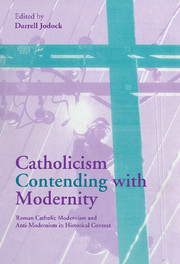 Catholicism Contending with Modernity
Catholicism Contending with Modernity Book contents
- Frontmatter
- Contents
- List of contributors
- Acknowledgments
- List of abbreviations
- Note on the text
- Introduction I: The Modernist crisis
- Introduction II: The Modernists and the anti-Modernists
- PART I THE LATE NINETEENTH-CENTURY SETTING OF MODERNISM AND ANTI-MODERNISM
- PART II MAURICE BLONDEL AND ALFRED LOISY IN FRANCE
- 4 Seeking transcendence in the modern world
- 5 Blondel's Action and the problem of the University
- 6 The politics of Loisy's Modernist theology
- 7 Innovation and biblical interpretation
- PART III FRIEDRICH VON HÜGEL AND MAUDE PETRE IN ENGLAND
- PART IV SOCIAL MODERNISM AND ANTI-MODERNISM IN FRANCE
- Conclusion
- Index
7 - Innovation and biblical interpretation
Published online by Cambridge University Press: 30 October 2009
- Frontmatter
- Contents
- List of contributors
- Acknowledgments
- List of abbreviations
- Note on the text
- Introduction I: The Modernist crisis
- Introduction II: The Modernists and the anti-Modernists
- PART I THE LATE NINETEENTH-CENTURY SETTING OF MODERNISM AND ANTI-MODERNISM
- PART II MAURICE BLONDEL AND ALFRED LOISY IN FRANCE
- 4 Seeking transcendence in the modern world
- 5 Blondel's Action and the problem of the University
- 6 The politics of Loisy's Modernist theology
- 7 Innovation and biblical interpretation
- PART III FRIEDRICH VON HÜGEL AND MAUDE PETRE IN ENGLAND
- PART IV SOCIAL MODERNISM AND ANTI-MODERNISM IN FRANCE
- Conclusion
- Index
Summary
This book showed that M. Loisy stood in the forefront of the biblical controversy, that several of the ideas for which he had been persecuted have become part of what is taught, that those who had opposed him had been able to counter only with a puerile apologetic, tainted by bogus methods: brazen denials, shameless affirmations, cynical retractions … Several excused the author for recognizing the importance of Loisy's role, but they did not pardon him for exposing the weakness of the official apologetics of M. Vigouroux.
Albert Houtin, on his La Question biblique chez les catholiques de France au XIXe siècle (1902)LOISY: INTELLECTUAL AND INSTITUTIONAL CONTEXTS
In any account of the Modernist movement Alfred Firmin Loisy (1857–1940) would claim a central role, given the prominence of his own person and that of biblical criticism in shaping the crisis. The sheer quantity of his published output contributed to Loisy's pre-eminence. That, however, is merely the backdrop. More salient would be the notoriety gained by a few of those publications, most notably L'Evangile et l'Eglise (The Gospel and the Church) (1902), the book that could be said to have precipitated the Modernist crisis. Part of Loisy's prominence could also be attributed to the background from which he stood out: the state of biblical studies in latter nineteenth-century Catholicism. Even to those untrained in exegesis the rather low level of Catholic scholarship in this area was glaringly apparent.
- Type
- Chapter
- Information
- Catholicism Contending with ModernityRoman Catholic Modernism and Anti-Modernism in Historical Context, pp. 191 - 212Publisher: Cambridge University PressPrint publication year: 2000
- 4
- Cited by


